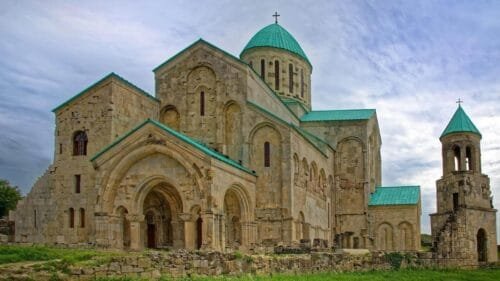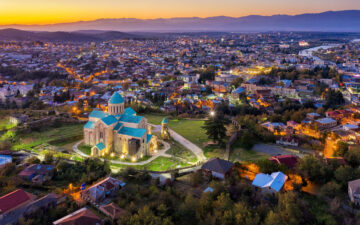Reliable car rental in Kutaisi with great prices and flexible pickup options. Choose your vehicle and book online quickly for a smooth travel experience.
Rent a Car in Kutaisi or Delivery to Any Place
You’re landing in Georgia, excited for what’s ahead, but there’s a question itching at you: how do you actually get around? If you’re looking to explore the country your way — not stuck to bus timetables or tour groups — you’re about to discover a surprisingly easy solution. And no, it doesn’t involve complicated bookings or waiting around. Let’s take a closer look at why renting a car in Kutaisi might just be your best move — whether you’re staying in town or need the car delivered somewhere else entirely.
Book Now
Attention! Business hours are optional for any location. We work 24 hours a day, 7 days a week, without weekends and holidays! Prices for Pick-Up and Return do not change depending on the time of day!
- Pick-Up: 75 USD
- Return: 75 USD
- Early Pick-Up: 75 USD
- Late Return: 75 USD
- Mondays: 08:00 - 20:00
- Tuesdays: 08:00 - 20:00
- Wednesdays: 08:00 - 20:00
- Thursdays: 08:00 - 20:00
- Fridays: 08:00 - 20:00
- Saturdays: 08:00 - 20:00
- Sundays: 08:00 - 20:00
Why Start Your Journey in Kutaisi?
Kutaisi is one of Georgia’s most authentic cities. It’s less polished than Tbilisi, and that’s part of the charm. When you pick up your car here, you’re already at the heart of western Georgia. Just minutes from the centre, you’ll find Bagrati Cathedral, a UNESCO World Heritage Site that sits on a hill with sweeping views of the city. Walk up there at sunset — the orange glow across the rooftops is unforgettable.

Prefer nature to city streets? Kutaisi gives you both. The Gelati and Motsameta monasteries are perched above forested hills, the kind you’d expect to see in a fairy tale. If you’re into caves and unique geology, Tsutskhvati Cave is not far. Or take it slow at the Sataplia Nature Reserve, where dinosaurs once roamed. There’s a glass walkway that stretches out over the forest canopy — not for the faint of heart!
Kutaisi Car Hire – Anywhere You Need
One of the best things about hiring a car here? You don’t need to be in Kutaisi to get it. Maybe you’ve already reached Batumi or you’re staying in a small village in Imereti. We get it — not everyone’s itinerary follows the standard tourist track. That’s why our car hire in Kutaisi – fast delivery anywhere service exists. You tell us where you are, and we make sure the car gets to you. Simple.
Car Rental Kutaisi – We Deliver to Any Place
Whether you’re arriving at the Kutaisi International Airport or relaxing at a guesthouse outside the city, delivery is never a problem. Our team often delivers to places like:
- Downtown Kutaisi hotels and apartments
- Kutaisi train station
- Nearby towns like Tskaltubo or Zestaponi
- Rural guesthouses across Imereti
Once, we even delivered to a family who were picnicking in Sataplia — that’s how far we’re willing to go to help you get on the road.
How Easy Is the Rental Process?
We like to keep things simple. You send us your basic info, we confirm availability, and you choose where and when you want the car. No need to queue. No hidden steps. Many of our customers say the part they like most is the lack of fuss.
We also provide help in English — spoken, written, even via WhatsApp if that’s easier. You won’t be left scratching your head over confusing instructions.
Real People, Real Experiences
One guest from the UK told us she’d never driven outside England before but felt confident after a 10-minute walkthrough at delivery. Another couple from Poland had the car dropped off to them in the village of Geguti, so they could visit the ruins before heading to Svaneti. We’ve even had solo travellers picking up cars in Kutaisi and driving all the way to Armenia.
And the roads? Not always perfect, but if you drive with caution and avoid night-time mountain drives (especially in winter), you’ll be just fine. Think of it as part of the adventure.
Car Hire in Kutaisi – Fast Delivery Anywhere
We know travel plans change. Sometimes buses get cancelled, or your guesthouse is further than you expected. That’s why we offer flexible delivery options, even if your plan shifts last minute. A lot of travellers are surprised by just how personal the service feels. We’re not a giant call-centre-type company — we’re locals who want you to see Georgia the way we do.
Explore Georgia at Your Own Pace
Having a car in Kutaisi means you set the pace. Want to stop at a roadside honey stand? Do it. Fancy a detour into the Racha region? Go. The freedom to explore is what turns a good trip into a great one.
If you’re planning to explore Georgia in a way that suits you — unhurried, flexible, and full of discovery — rent a car in Kutaisi or delivery to any place is your ticket. Don’t just see Georgia. Drive through it. Feel it. Make it your own.
Still unsure? Drop us a message. We’re happy to chat and help you figure out if renting a car is right for your adventure.
Ready to Start Your Adventure?
Book your car rental at Ambrolauri Airport now and enjoy the freedom to explore Racha at your own pace.
Simple, fast, and with delivery right at the airport — no hassle, just the road ahead.
